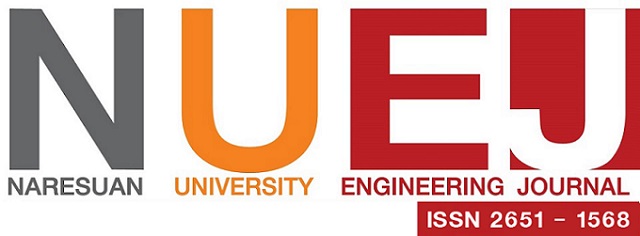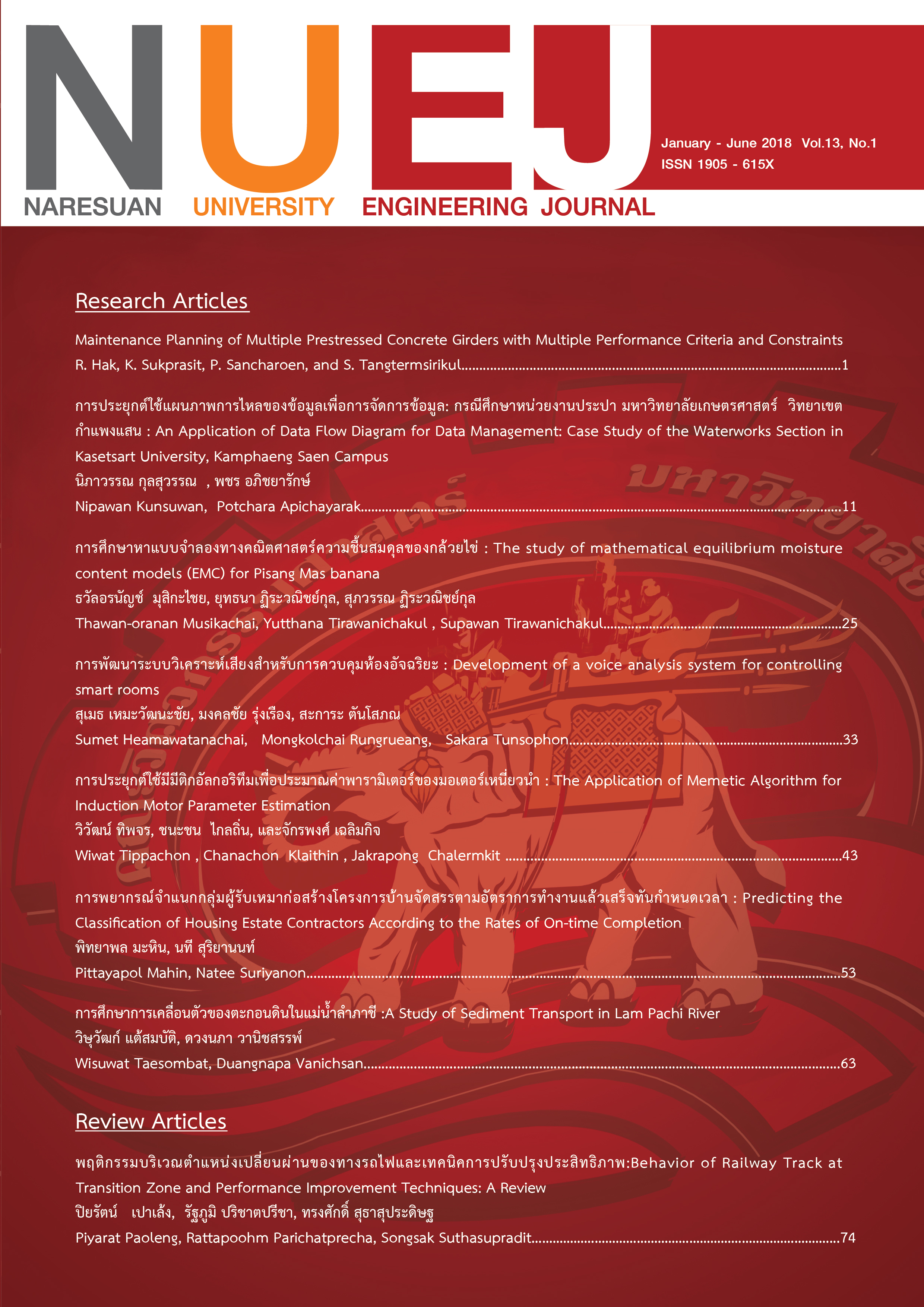การศึกษาหาแบบจำลองทางคณิตศาสตร์ความชื้นสมดุลของกล้วยไข่
Main Article Content
บทคัดย่อ
วัตถุประสงค์ของงานวิจัยนี้เพื่อหาค่าความชื้นสมดุลของกล้วยไข่ด้วยวิธีการทางสถิต ที่อุณหภูมิแวดล้อมในช่วงระหว่าง 45 ถึง 65°C ซึ่งสัมพันธ์กับความชื้นสัมพัทธ์แวดล้อมในช่วง 0.11-0.86 และนำผลการทดลองที่ได้มาวิเคราะห์และสร้างแบบจำลองสมการความชื้นสมดุลของกล้วยไข่โดยเลือกใช้สมการแบบจำลองทางคณิตศาสตร์ 9 สมการ (Oswin, GAB, Chung-Pfost, Cauric, Kuhn, Smith, White and Eiring, Modified Smith และ Modified Oswin) จากผลการวิเคราะห์ สรุปได้ว่า ที่อุณหภูมิสภาวะแวดล้อมหนึ่ง ๆ ค่าความชื้นสมดุลของกล้วยไข่จะมีความสัมพันธ์แบบไม่เชิงเส้นกับค่าความชื้นสัมพัทธ์ของสภาวะอากาศแวดล้อม และค่าความชื้นสมดุลของกล้วยไข่จะเป็นสัดส่วนผกผันกับค่าอุณหภูมิของสภาวะแวดล้อม จากผลการสร้างแบบจำลองทางคณิตศาสตร์เพื่ออธิบายการเปลี่ยนแปลงความชื้นสมดุลกับสภาวะแวดล้อมนั้น จะพิจารณาสมการแบบจำลองทางคณิตศาสตร์ที่เหมาะสมที่สุดจากค่าสัมประสิทธิ์ของการตัดสินใจที่สูงสุด (R2) และค่ารากที่สองของค่าเฉลี่ยของความคลาดเคลื่อนกำลังสอง (RMSE) ค่าผลรวมของความผิดพลาดกำลังสอง (SSE) และค่าไคสแควร์ (c2). ที่ต่ำที่สุด และผลการวิเคราะห์สรุปได้ว่า สมการแบบจำลองทางคณิตศาสตร์ความชื้นสมดุลของ GAB สามารถทำนายค่าความชื้นสมดุลของกล้วยไข่ได้เหมาะสมที่สุด และสมการนี้สามารถนำไปใช้ในการประยุกต์ใช้สำหรับการหาค่าความชื้นของกล้วยไข่เมื่ออยู่ในสภาวะแวดล้อมต่าง ๆ ในช่วงค่าอุณหภูมิและความชื้นสัมพัทธ์อากาศแวดล้อมในเขตร้อนชื้นเพื่อเก็บรักษากล้วยไข่คุณภาพได้เป็นอย่างดี
Article Details
References
Department Of Industrial Promotion. (2016). Benefit of banana. Available at: http://www.thaitechno.net/t1 /knowledge. php?uid=39487.
Kluai Khai. (2017), Banana Information. Availableat:http://www.bananahealthy.com/%E0%B8%81%E0%B8%A5%E0%B9%89%E0%B8%A7%E0%B8%A2%E0%B9%84%E0%B8%82%E0%B9%88/
Pornpun, R. (2016). Nutrition of Thai food (Table). Availableat: http://www.booktime.co.th/new /article_ detail .php?t_id=1403000022#.VGIuYvmsXoE.
Sasiwimon, S., Jamon, S., Samutchai, C. (2016). Banana Thai. Available at: http://www.sc.mahidol ac. th/scpl/banana/LepMueNang.htm.
Chanun, R., Sunate, S. (2012). Determination of Moisture Sorption Isotherm for Hygroscopic Materials, 18(1), 43-51.
Tawarat, T., Somyot, C. (2009). Equilibrium Moisture Content and Drying of Phlai (Zingiber cassumunar Roxb.), Thai society of Agricultural Engineering, 10.
Wasan, J., Thossaporn, C., Sutep C., Chalerm, S. (2012). Comparison of mathematical model equilibrium moisture content for sheet rubber. KKU Engineering Journal, 39(1), 11-21.
Oswin, C. R. (1946). The kinetics of package life. III. The isotherms. Journal of Chemical Industry, 65, 419-423.
Asma, K.B., Nourhène, B.M., & Nabil, K. (2012). Moisture sorption isotherms Experimental and mathematical investigations of orange (Citrus sinensis) peel and leaves. Journal of Food Chemistry, 132, 1728-1735.
Ali, Z., Zahra, K., & Leila, M. (2011). Determination of EMC isotherms and appropriate mathematical models for canola. Journal of Food and Bioproducts Processing, 89, 407-413..
Gokhan, B., Bhagwati, P., & Zhongli, P. (2012). Dynamic vapor sorption isotherms of medium grain rice varieties. Journal of LWT - Food Science and Technology, 48, 156-163.
AOAC. Official method of analysis, 16th ed., (2000). The Association of Official Analytical Chemists. Inc. Arlington, Verginia, USA.
Pfost, H.B., Mourer, S.G., Chung, D.S., Milliken, G.A., (1976). Summarizing and Reporting Equilibrium Moisture Data for Grains. ASEA Paper No. 76-3520. St. Joseph, MI.
Chen, C., Jayas, D.S., (1998). Evaluation of the GAB equation for the isotherms of agricultural products. Trans. ASABE, 41, 1755-1760.
Van der Berg, C., Bruin, S., (1981). Water activity and its estimation in food systems; theoretical aspects. In: Rockland, L.B., Stewart, G.F. (Eds.), Water Activity: Influences on Food Quality Academic Press Inc., New York, pp. 1, 61.
Pak, S.L., Shahab, S., Xiaotao T.B., C. Jim Lim., & Sylvia H.L. (2012). Drying characteristics and equilibrium moisture content of steam-treated Douglas fir (Pseudotsuga menziesii L.). Journal of Bioresource Technology, 116, 396-402.
Chen, C., (2000). Rapid model to determinate the sorption isotherms of peanuts. Journal of Agricultural Engineering Research, 75, 401-408.
A. Iguaz, P. Virseda. (2007). Moisture desorption isotherms of rough rice at high temperatures. Journal of Food Engineering, 79, 794-802.
Castillo, M.D., Martinez, E.J., Gonzalez, H.H.L., Pacin, A.M., & Resnik, S.L., (2003). Study of mathematical models applied to sorption isotherms of Argentinean black bean varieties. Journal of Food Engineering. 60, 343-348.
Smith, S.E., (1947). Sorption of wheat vapour by high polymers. Journal of the American Chemical Society, 69, 646-651.
Neila, B., Nourhene, B., & Nabil, K. (2008). Moisture desorption adsorption isotherms and isosteric heats of sorption of Tunisian olive leaves (Olea europaea L.). Journal of industrial crops and products, 28, 162-176.
Guggenheim, E. A. (1966). Application of statistical mechanics. Oxford Clarendon Press.
Anderson, R. B. (1946). Modification of the Brunauer, Emmett and Teller equation.Journal of the American Chemical Society, 68, 686-691
De Boer, J. H. (1953). The dynamic character of adsorption. Oxford Clarendon Press.
Rockland, L.B., Stewart, G.F., (1981). Water Activity Influence on Food Quality. New York:
Acedemic Press.

